How much time does an hour of salt spray test equal to the natural environment?
Many customers using the HONYONE switch have asked how long the on-off salt spray test time is equivalent to one hour of field use? Don\’t worry, let\’s first understand some principles and common questions of salt spray test. The switch parts of HONYONE factory and IQC incoming materials are all tested in the laboratory for 48 hours. The answer will be published at the end of this article after you read it.
Principle of salt spray corrosion
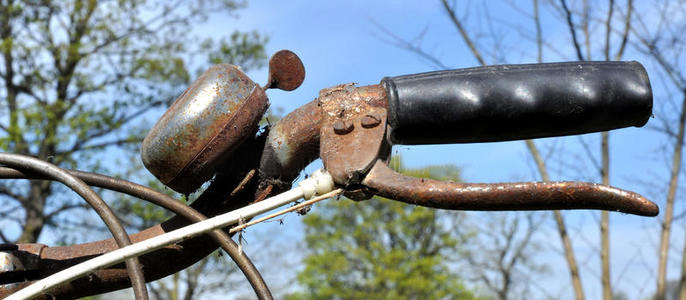
Most of the corrosion of metal materials occurs in the atmosphere, which contains corrosive components and factors such as oxygen, humidity, temperature change and pollutants. Salt spray corrosion is one of the most common and destructive atmospheric corrosion.
The corrosion of metal materials caused by salt spray is mainly caused by the conductive salt solution penetrating into the metal and electrochemical reaction occurs, forming the micro-cell system of "low-potential metal-electrolyte solution and high-potential impurities", and electron transfer occurs, and the metal as anode dissolves, forming a new compound, namely the corrosion substance. In the process of salt spray corrosion damage, the main role is chloride ion, it has a strong penetrating ability, easy to penetrate the metal oxide layer into the metal interior, destroy the blunt metal; At the same time, the chloride ion has a very small hydration energy, easy to be adsorbed on the surface of the metal, replace the oxygen in the oxide layer that protects the metal, so that the metal is damaged.
Test method and classification of salt spray corrosion
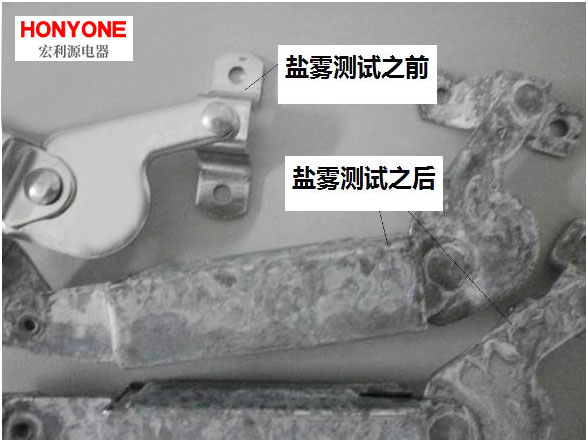
Before and after the salt spray test
Salt spray testing is an accelerated corrosion assessment method for artificial atmospheres. It atomizes a certain concentration of brine; Then spray in a closed constant temperature box, by observing the sample to be tested in the place in the oven after a period of change to reflect the corrosion resistance of the test samples, it is an accelerated test method, the salt spray environment of chloride salt concentration, but the general content of natural environment, salt fog several times or more, make the corrosion speed is greatly increased, salt fog test was carried out on the product, the results of time is greatly shortened.
Testing a sample of a product in a natural environment can take a year or even years to corrode.Similar results can be obtained in a few days or even hours under artificial conditions that simulate salt spray.
There are four main types of salt spray tests:
Neutral salt spray test (NSS); Acetate mist test (AASS); Copper accelerated acetate mist test (CASS); Alternating salt spray test.
Comparison of 4 salt spray test methods in GB/T 10125
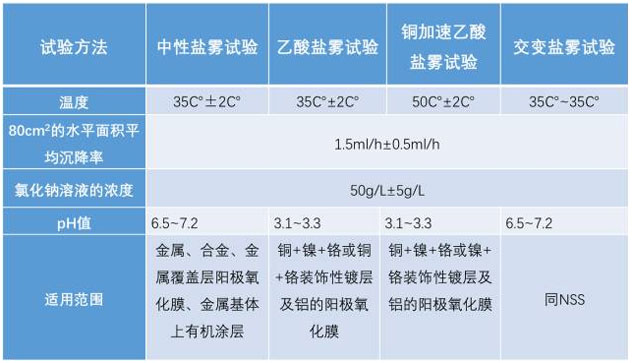
Structure drawing of salt spray corrosion test chamber:
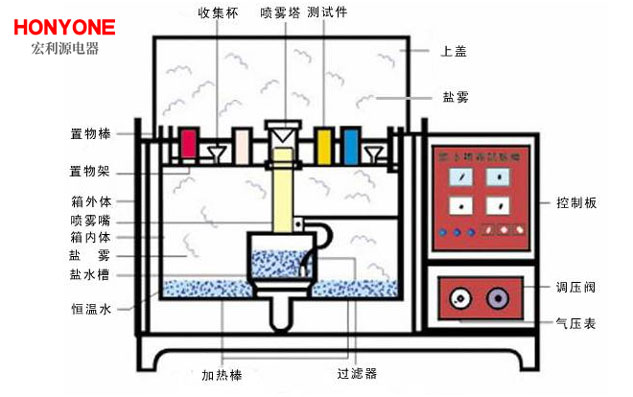
Salt spray corrosion test equipment diagram:
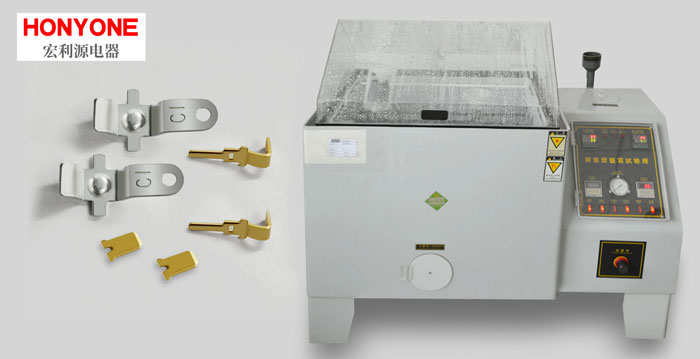
Evaluation of salt spray test results:
The methods for evaluating the results of salt spray test include: grading method; Assessment method for the occurrence of corrosive substances; Weighing method.
The rating method
The percentage of the ratio of the corrosion product to the total product is divided into several grades according to a certain method, and a certain grade is taken as the criterion of conformity. It is suitable for the evaluation of flat sample. For example, GB/T6461-2002, ISO 10289-2001, ASTM B 537-70(2013), AND ASTM D 1654-2005 all use this method to evaluate the salt spray test results.
Protect ratings and appearance ratings
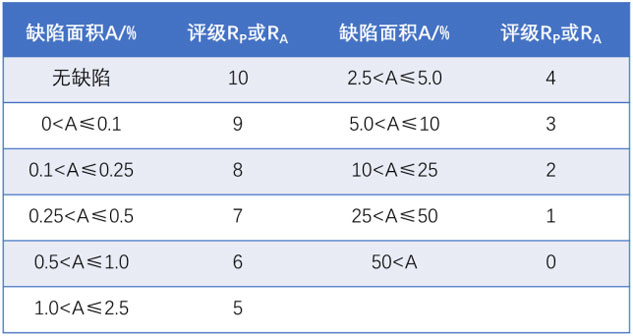
Calculation method of RP and RA values:

RP - Protection rating value;
RA- Appearance rating value;A - When calculating RP, is the percentage of the corroded part of the base metal in the total area; When RA is calculated, it is the percentage of the corroded part of protective layer in the total area.
Overlay classification and subjective evaluation
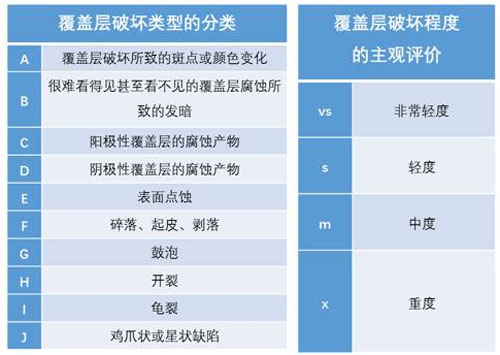
The protection rating is expressed as :RA/—
For example, when the slight rust exceeds 1% of the surface and is less than 2.5% of the surface, it is expressed as: 5/—
The presentation method of appearance rating is: —/RAvalue + subjective evaluation + coverage damage rating
For example: moderately spotted, area more than 20%, denoted as: —/2mA
The performance rating is expressed as: RA + subjective evaluation + coverage failure level
For example, the sample showed no corrosion of the base metal, but mild corrosion of the anodic covering layer less than 1% of the total area, which was expressed as 10/6SC
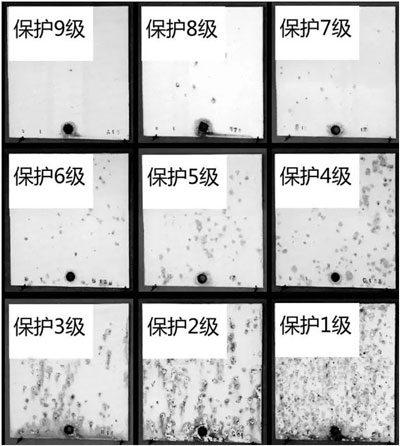
A photograph of a coating that is negatively polar to the base metal
Method for evaluation of corrosion appearance
Is a qualitative determination method, it to salt spray corrosion test, whether the product corrosion phenomenon to liu a sample to determine. For example, JB4159-1999, GJB4.11-1983, GB/T4288-2003 used this method to evaluate the salt spray test results.
Table of corrosion characteristics of common electroplating parts after salt spray test
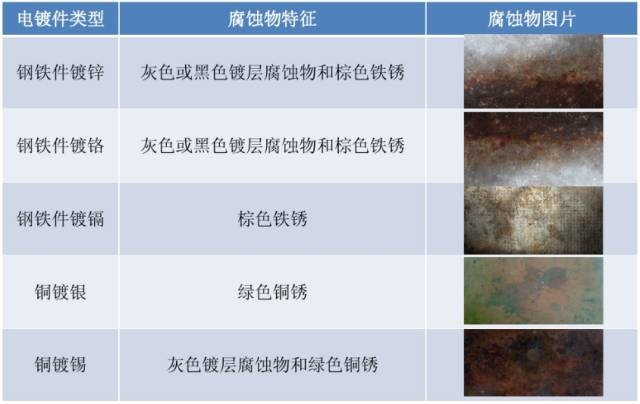
Weighing method
The method is to weigh the weight of the sample before and after the corrosion test and calculate the weight of the corrosion loss to evaluate the corrosion resistance quality of the sample. It is especially suitable for the assessment of the corrosion resistance quality of a certain metal.
Corrosion rate calculation method:

V loss - metal corrosion rate,g/m2·h;m0 — the mass of the specimen before corrosion, g;m1 —the mass of the specimen before corrosion, g; S -- the area of the specimen, m2; t — the corrosion time of the specimen, h.
Influencing factors of salt spray test
Test temperature and humidity:
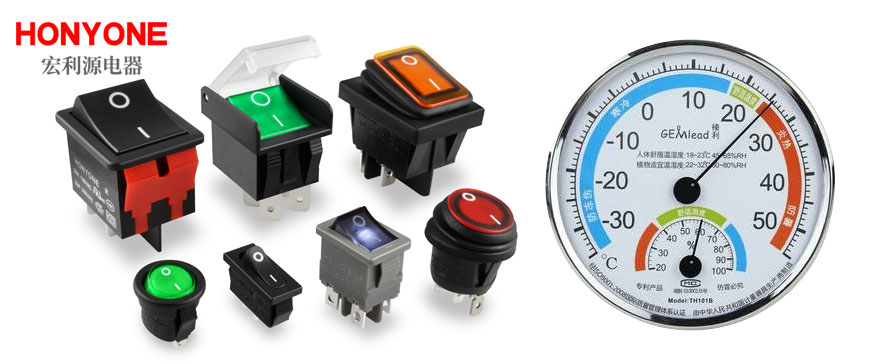
The critical relative humidity for metal corrosion is about 70%. When the relative humidity reaches or exceeds this critical humidity, the salt will be delisted to form an electrolyte with good conductivity. When the relative humidity decreases, the concentration of salt solution will increase until crystalline salt is precipitated, and the corrosion rate will decrease accordingly. The higher the temperature, the more the molecules move, and the faster the salt spray corrosion rate. The International Electrotechnical Commission points out that the corrosion rate increases 2 ~ 3 times and the conductivity of electrolyte increases 10 ~ 20% for every 10℃ increase of temperature. For the neutral salt spray test, it is generally considered that 35℃ is the appropriate test temperature.
Concentration of solution
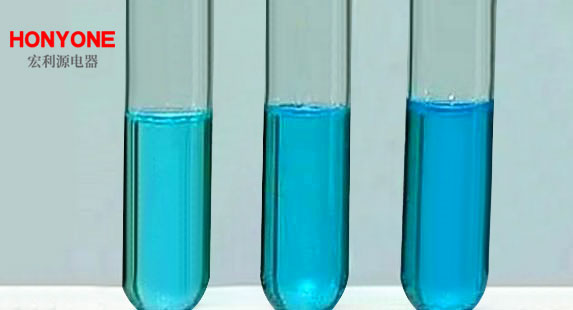
When the concentration is below 5%, the corrosion rate of steel, nickel and brass increases with the increase of the concentration. When the concentration is greater than 5%, the corrosion rate of these metals decreases with the increase of concentration. This is because, in the low concentration range, oxygen content increases with salt concentration; When the salt concentration increases to 5%, the oxygen content reaches relative saturation, and if the salt concentration continues to increase, the oxygen content decreases correspondingly. As the oxygen content goes down, so does the depolarizing capacity of oxygen, which means the corrosion is reduced. For zinc, cadmium, copper and other metals, the corrosion rate always increases with the increase of salt solution concentration.
Sample placement Angle
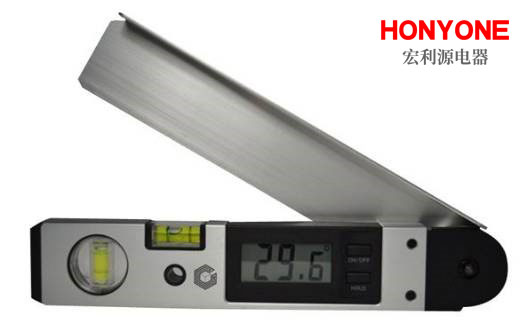
The settling direction of salt mist is close to the vertical direction. When the sample is placed horizontally, its projected area is the largest and the salt mist amount borne on the sample surface is the largest, so the corrosion is the most serious. The results show that when the steel plate is at a 45 degree Angle to the horizontal line, the corrosion loss weight per square meter is 250 g, and when the steel plate is parallel to the vertical line, the corrosion loss weight per square meter is 140 g. GB/T 2423.17-93 Standard specifies that flat samples shall be placed at an Angle of 30 degrees from the vertical direction of the test surface.
ph value
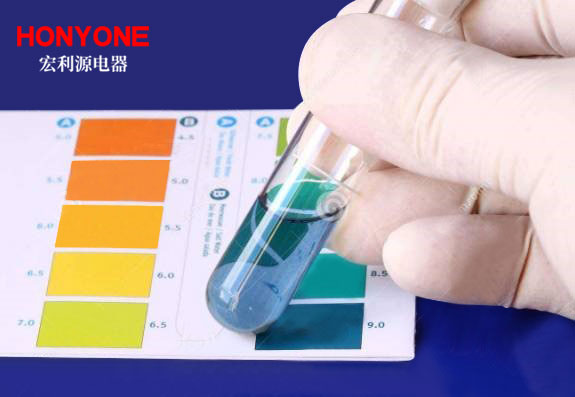
The lower the pH, the higher the concentration of hydrogen ions in the solution, the more acidic and corrosive the solution. The pH value of neutral salt spray test (NSS) was 6.5~7.2. The pH of salt solution will change due to environmental factors. In order to improve the reproducibility of salt spray test results, the range of pH value of salt solution is stipulated in the salt spray test standard at home and abroad.
Precipitation of salt spray and spray method:
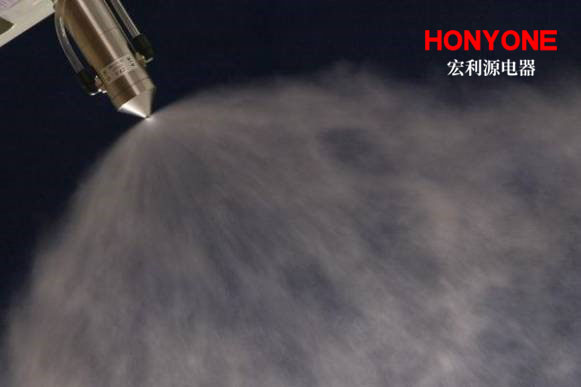
The finer the salt spray particles are, the greater the surface area they form, the more oxygen they absorb, and the more corrosive they are. The most obvious disadvantages of the traditional spray methods are the poor uniformity of salt spray sedimentation and the large diameter of salt spray particles. Different spray methods also have an effect on the pH of the salt solution.
Standards related to salt spray test:
How long does an hour of salt spray test equal to the natural environment?
Standard no
The name of the standard
GB/T 10125-2012
Artificial atmosphere corrosion test salt spray test
GB/T 12967.3-2008
Methods for detection of anodic oxidation films of aluminium and aluminium alloys - Part 3: Copper accelerated acetate mist test (CASS)
GB/ T6461-2002
Grades of samples and specimens after corrosion tests for metals and other inorganic coatings on metal substrates
GB/T 2423.17-2008
Environmental tests for electrical and electronic products - Part 2: Test methods: Test Ka: salt spray
GB/T 2423.18-2012
Environmental tests - Part 2: Test methods - Test Kb: salt spray, alternating (sodium chloride solution)
JB 4159-1999
General technical requirements for tropical electrical products
GJB 4.11-1983
Marine electronic equipment environmental test salt spray test
ASTM B 117-2007
Standard Practice for Operating Salt Spray (Fog) Apparatus
ASTM B 368-2003
Standard Test Method for Copper-Accelerated Acetic Acid-Salt Spray (Fog) Testing
ASTM B 537-70 (2013)
Standard Practice for Ratingof Electroplated Panels Subjected to Atmospheric Exposure
ASTM D 1654-2005
Standard Test Method for Evaluation of Painted or Coated Speciments Subjected to Corrosive Environment
ASTM G 85 -2011
Standard Practice for Modified Salt Spray (Fog) Testing
There are two kinds of salt spray tests, one is natural environmental exposure test, the other is artificial accelerated simulated salt spray environmental test. The artificial simulated salt spray environment test is a kind of test equipment with a certain volume space, salt spray test box, in its volume space, the artificial method to salt spray environment to test the quality of corrosion resistance to salt spray. Compared with the natural environment, the salt concentration of chloride in the salt spray environment can be several times or dozens of times of the salt spray content in the general natural environment, which greatly improves the corrosion rate and shortens the time of obtaining the results by conducting the salt spray test on the products. If a sample of a product is tested under natural exposure, it may take one year for its corrosion to occur, while a similar result can be obtained after 24 hours of testing under artificially simulated salt spray conditions.
The artificial simulated salt spray test includes neutral salt spray test, acetate spray test, copper accelerated acetate spray test and alternating salt spray test.
(1) Neutral salt spray test (NSS test) is the earliest and most widely used accelerated corrosion test method. It USES 5% sodium chloride saline solution with a neutral PH range (6 ~ 7) as the spray solution. The test temperature was all set at 35℃, and the sedimentation rate of salt spray was required to be between 1 ~ 2ml/80cm. H.
(2) Acetate mist test (ASS test) is developed on the basis of neutral salt mist test. It is in 5% sodium chloride solution to add some glacial acetic acid, so that the PH value of the solution to 3 or so, the solution becomes acidic, the final formation of salt fog from the neutral salt fog into acid. Its corrosion rate is about three times faster than the NSS test.
(3) Accelerated copper acetate mist test (CASS) is a kind of rapid salt spray corrosion test developed recently in foreign countries. The test temperature is 50℃, and a small amount of copper salt -- copper chloride is added into the salt solution to strongly induce corrosion. Its corrosion rate is about 8 times that of the NSS test.
The specific time is converted into:
Neutral salt spray test for 24 h ⇌ natural environment 1 year
Acetic acid salt spray test for 24 h ⇌ natural environment for 3 years
Copper salt accelerated acetic acid salt spray test for 24 h ⇌ natural environment for eight years
Through the study of the above article, I believe that we have a comprehensive understanding of the electronic switch salt spray experiment. Therefore, HONYONE promised 24H hydrochloric acid test in the product test report, which is equivalent to 3 years\’ use results in the natural environment. If the salt spray experiment passes 48H, it is equivalent to using in the natural environment for 5-6 years.
HONYONE Quality department
2020-7-28


